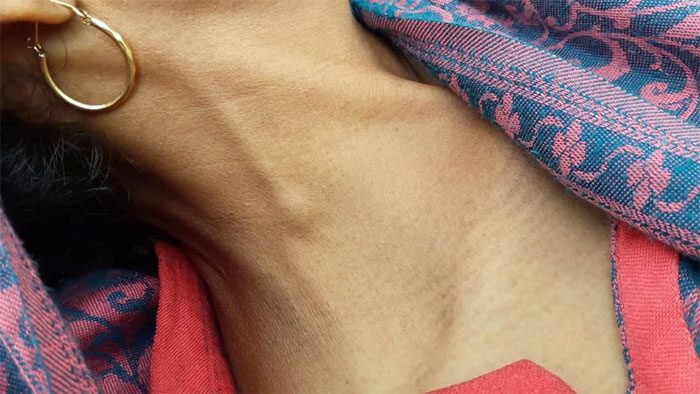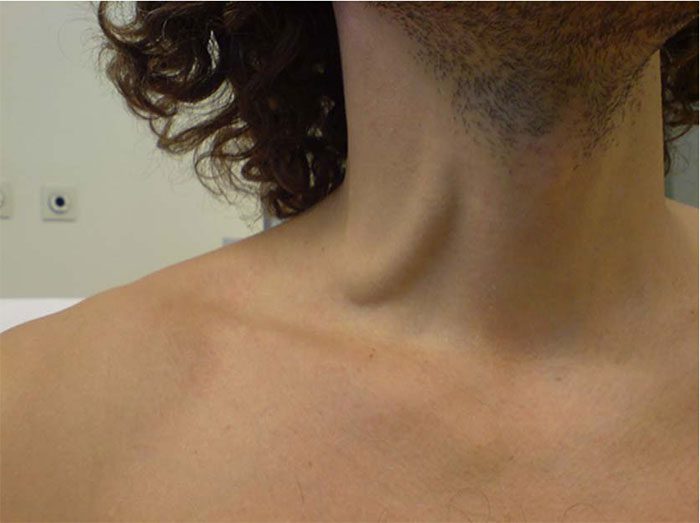Jugular Vein Distension, also known as jugular vein dilation, is characterized by swollen veins in the neck, which may or may not be painful.
Jugular Vein Distension: Causes, Symptoms, and Treatment
1. What is Jugular Vein Distension?
The veins in the neck are referred to as the jugular veins, which include the external jugular vein and the internal jugular vein. These veins transport blood from the head to the superior vena cava, the largest vein in the upper body. The superior vena cava then carries blood to the heart and lungs.
Jugular vein distension occurs when there is increased pressure in the superior vena cava, causing the external jugular vein to bulge. This condition is typically more pronounced on the right side of a person’s neck.
The appearance of the vein resembles a cord or a tube that protrudes beneath the skin’s surface.

Jugular vein distension is the bulging of veins in the neck. (Image: Internet).
2. Causes of Jugular Vein Distension
Jugular vein distension is associated with several serious health conditions that affect the heart and lungs, including:
2.1. Right Heart Failure
Right heart failure is a condition where the right side of the heart does not pump blood effectively. This often occurs following left heart failure, leading to increased pressure in the right side. Over time, the right side weakens and is unable to function properly.
Blood then accumulates in the veins, resulting in bulging of the jugular vein. Symptoms may include shortness of breath, swelling, fatigue, and visible veins in the neck.
2.2. Pulmonary Hypertension
Pulmonary hypertension occurs when blood pressure in the vessels between the heart and lungs is excessively high. The pulmonary arteries carry blood from the right ventricle of the heart to the lungs. When pressure rises in this area, pulmonary hypertension develops.
Symptoms can range from mild to severe. In mild cases, there may be no symptoms; however, in more severe cases, it can cause pain and loss of consciousness. Other symptoms may include shortness of breath, fatigue, chest pain, and swelling.
Pulmonary hypertension can cause the jugular veins to appear due to increased pressure within the veins, leading to bulging.

Jugular distension is often related to heart and lung diseases. (Image: Internet).
2.3. Constrictive Pericarditis
Constrictive pericarditis is a chronic condition where the pericardium—the membrane surrounding the heart—becomes stiff and less elastic. This loss of elasticity affects heart function, leading to increasingly severe symptoms.
Individuals with this condition often have a thickened or calcified pericardium, which can cause dilatation of major veins due to blood pooling. One of these veins is the jugular vein.
Constrictive pericarditis is relatively rare but can be chronic and life-threatening if not treated.
2.4. Superior Vena Cava Obstruction
The superior vena cava is one of the major veins of the body, transporting blood from the arms, chest, neck, and head back to the heart. The jugular vein connects to the superior vena cava. When there is an obstruction in the superior vena cava, the veins in the neck may also become compressed or obstructed.
Depending on the severity of the obstruction, individuals may experience mild symptoms or none at all. However, this obstruction can progress, leading to severe symptoms, including chest pain, coughing up blood, and wheezing.
Obstruction of the superior vena cava is rare but serious, often caused by severe conditions like cancer or infections.
2.5. Cardiac Tamponade
Cardiac tamponade is a medical emergency where blood and fluid accumulate in the pericardial sac, compressing the heart. When this occurs, cardiac output is diminished and may lead to shock, causing a sudden decrease in blood flow throughout the body.
Fluid accumulation causing cardiac tamponade can result from bleeding from a penetrating wound to the heart or rupture of the heart wall after a heart attack.
Common symptoms of cardiac tamponade include chest pain, palpitations, shortness of breath, and altered mental status. Individuals with cardiac tamponade may also experience jugular vein distension due to blood pooling in the veins.

Individuals with cardiac tamponade may also experience jugular vein distension due to blood pooling in the veins. (Image: Internet).
2.6. Tension Pneumothorax
Tension pneumothorax is a condition where the lung collapses due to air accumulation between the lung and the chest wall, known as the pleural space, which cannot escape. It can be a complete or partial collapse of the lung.
Tension pneumothorax occurs when air accumulates between the chest wall and lung, increasing pressure in the chest cavity, thereby reducing the amount of blood returning to the heart. This condition can lead to jugular vein distension.
2.7. Tricuspid Valve Stenosis
The tricuspid valve is situated between the right atrium and right ventricle of the heart. Tricuspid valve stenosis is one of four types of tricuspid valve diseases. In tricuspid valve stenosis, the valve opening narrows, restricting blood flow between the upper and lower parts of the right heart.
This condition leads to right atrial enlargement, resulting in increased pressure and blood flow in the surrounding veins. Tricuspid valve stenosis often causes increased pressure in the jugular vein and bulging of the vein.
3. Symptoms of Jugular Vein Distension
The primary symptom of jugular vein distension is the visible bulging of the veins in the neck. Additionally, jugular vein distension may be accompanied by other symptoms, depending on the underlying cause.
For instance, if the distension is due to heart failure, patients may experience additional symptoms such as:
- Shortness of breath
- Chest pain
- Loss of appetite
- Fatigue
- Palpitations
- Coughing
- Blood-streaked mucus
Note: Since jugular vein distension is often associated with heart disease, if a patient experiences frequent chest pain and shortness of breath, they should seek immediate medical attention for evaluation and care.

Jugular vein distension can cause chest pain and shortness of breath when related to heart disease. (Image: Internet).
4. Risk Factors
The most common risk factor for jugular vein distension is heart failure. Heart failure can affect anyone, but individuals at higher risk include those with:
- High blood pressure
- Congenital heart defects
- Coronary artery disease and other heart issues
- Obesity
- Diabetes
- Smoking
- Excessive alcohol consumption
- Diet high in salt, fats, and cholesterol
- Lack of physical activity
Some lifestyle-related risk factors can be modified to reduce the risk of heart failure and other causes of jugular vein distension, such as:
- Quitting smoking
- Weight loss
- Regular exercise and activity
- Managing diabetes
- Improving diet, such as reducing salt intake
The level of fluid in your body can contribute to jugular vein distension. Therefore, you may discuss medications and other ways to manage or limit fluid with your doctor to minimize the risk of this condition.

An unhealthy lifestyle can lead to heart problems and increase the risk of jugular vein distension related to heart issues. (Image: Internet).
5. Treatment for Jugular Vein Distension
As jugular vein distension is a symptom of an underlying disease, treatment focuses on addressing the cause of the obstruction or congestion in the neck veins. These treatment methods will vary depending on the diagnosis.
Doctors typically try less invasive methods first. If your condition is not severe, they may recommend lifestyle changes and medications to reduce fluid volume in your body or improve heart function. These medications may include:
- Beta-blockers
- Diuretics
- Angiotensin-converting enzyme (ACE) inhibitors
In general, treatment methods will depend on the diagnosis made by the doctor. There are no home remedies that effectively alleviate symptoms or are particularly useful. However, maintaining a healthy lifestyle and diet remains essential to enhance health and support a smoother treatment process.


















































